

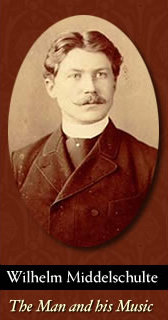
Brink Bush discovered the organ works of Wilhelm Middelschulte while searching for compositions by neglected romantic masters. He found Middelschulte's works to be of such significance that he embarked upon a journey to uncover the story behind the music. Travel to Westphalia, Germany and access to the Middelschulte family archives have led Bush to an in-depth knowledge of the life and career of this remarkable composer.
 Wilhelm Middelschulte was born in Heeren Werve, Germany, April 3, 1863; he died in Oespel on May 4, 1943.
Wilhelm Middelschulte was born in Heeren Werve, Germany, April 3, 1863; he died in Oespel on May 4, 1943.
Middelschulte's early organ studies were with August Knabe in Soest; later, at the Royal Academy of Church Music in Berlin: August Loeschhorn (piano), August Haupt (organ and theory), Julius Alsleben (history and conducting), Franz Commer and Herman Schroeder (composition). He was Assistant Organist (under Haupt) at the Parochial Kirche, and Associate Professor, Royal Academy of Church Music. From 1888 to 1891 Middelschulte was the Organist of St. Lucas Kirche, Berlin. He played for the memorial service of the German Emperor Friedrich III.
In 1891 Middelschulte moved to Chicago where he first held the post of Organist for the People's Church. Shortly thereafter he became the Organist and Director of Music of Holy Name Cathedral. At the Colombian Exposition in 1893, Middelschulte gave three recitals entirely from memory. In the next season he was invited to play with the Theodore Thomas Orchestra.
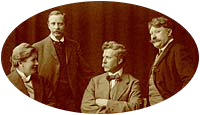 That same year Middelschulte performed Guilmant's First Symphony for Organ and Orchestra at the reopening of Holy Name Cathedral. From 1896-99 he was Organist and Choir Director of the University Congregational Church and from 1899-1918 he was concurrently Organist of the Chicago Symphony Orchestra, St. James Roman Catholic Church and K.A.M. Temple. In 1900 he was appointed Organist of the Cincinnati May Festival and in 1904 performed at the St. Louis Exposition.
That same year Middelschulte performed Guilmant's First Symphony for Organ and Orchestra at the reopening of Holy Name Cathedral. From 1896-99 he was Organist and Choir Director of the University Congregational Church and from 1899-1918 he was concurrently Organist of the Chicago Symphony Orchestra, St. James Roman Catholic Church and K.A.M. Temple. In 1900 he was appointed Organist of the Cincinnati May Festival and in 1904 performed at the St. Louis Exposition.
Middelschulte was Professor of Music at the American Conservatory, Cosmopolitan School of Music, Chicago; Wisconsin Conservatory, Milwaukee; and Detroit Conservatory of Music. He was also Visiting Professor at Rosary College and Notre Dame University, where he received an honorary doctorate in 1922. In addition, he was Visiting Post-Graduate Chair in Organ and Theory, State College for Church Music, Berlin, 1925-27.
"Your wonderful playing will never be forgotten.
…You are a great master."
![]() — Ferruccio Busoni
— Ferruccio Busoni
Middelschulte was widely acclaimed by contemporary critics such as Ferruccio Busoni, who described him as an equal with Bach, Franck, and Reger. He also proclaimed him "Master of Counterpoint." Middelschulte studied with the theorist Bernhard Ziehn (1845-1912), who had immigrated to Chicago from Erfurt in 1868. From Ziehn's theories Middelschulte learned the principle of symmetrical inversion which leads to unusual harmonies that arise from strict inversion of the chromatic line. Middelschulte's compositions represent the most important embodiment of the theories of Bernhard Ziehn.
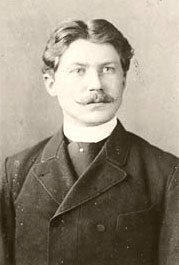
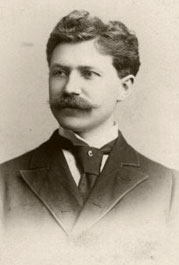 Studio portraits of Wilhelm Middelschulte as a young man, Berlin, 1880s
Studio portraits of Wilhelm Middelschulte as a young man, Berlin, 1880s
 Studio portrait of Wilhelm Middelschulte in later life, Chicago, 1930
Studio portrait of Wilhelm Middelschulte in later life, Chicago, 1930
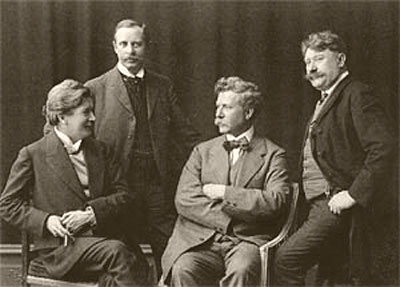 Left to right:
Left to right:
Ferrucio Busoni, Composer Pianist;
Frederick Stock, Conductor, Chicago Symphony Orchestra;
Wilhelm Middelschulte;
George Hüttner, Conductor, Dortmund Philharmonisches Orchester.
Dortmund, Germany, August 1911, on the occasion of the first performance of Stock's orchestration of Busoni's Fantasie Contrappuntistica.